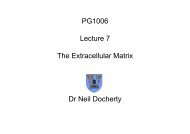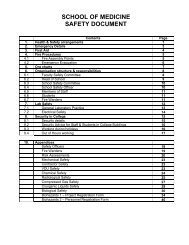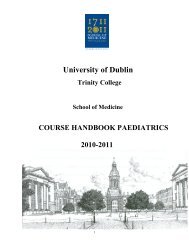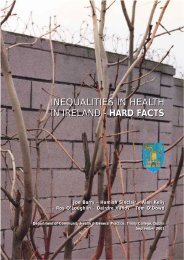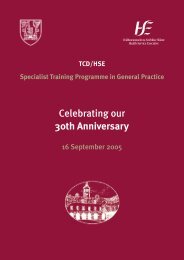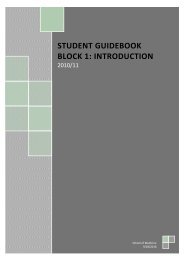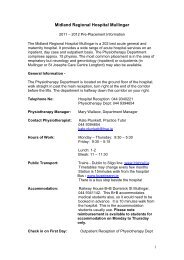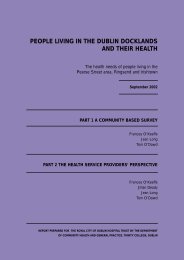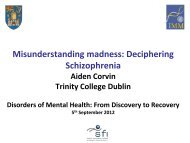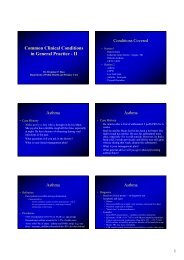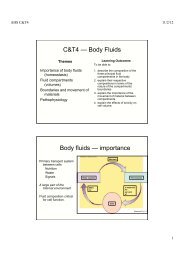year-2-study-guide-2.. - School of Medicine - Trinity College Dublin
year-2-study-guide-2.. - School of Medicine - Trinity College Dublin
year-2-study-guide-2.. - School of Medicine - Trinity College Dublin
You also want an ePaper? Increase the reach of your titles
YUMPU automatically turns print PDFs into web optimized ePapers that Google loves.
Module 2: CLINICAL BIOCHEMISTRY<br />
ECTS Value<br />
5 Credits<br />
Lecturers<br />
Biochemistry lectures cover Introduction (Porter 1 lecture)<br />
Coagulation (Preston 6 lectures)<br />
Extracellular matrix (Carroll 4 lectures)<br />
Clinical Endocrinology (Boran 8 lectures)<br />
Clinical Biochemistry (Smith 7 lectures)<br />
Immunology (Jackson/Feighery/Kelly/Doherty 10 lectures/2 tutorials)<br />
Molecular mechanisms <strong>of</strong> metabolic diseases (Nolan/ Pazderska /Wanic 4 lectures)<br />
Aims<br />
The purpose <strong>of</strong> the course is to enable the students to understand and interpret core<br />
aspects <strong>of</strong> “clinical biochemistry” and immunology that they will encounter in the<br />
course <strong>of</strong> their careers as medical doctors. Prerequisites include a knowledge <strong>of</strong> the<br />
fundamentals <strong>of</strong> biochemistry. The course is mandatory. The lecture is there to<br />
facilitate understanding <strong>of</strong> the courses provided.<br />
Course Content<br />
The Extracellular Matrix: Dr. Joe Carroll (4 lectures)<br />
1. The extracellular matrix: overview <strong>of</strong> composition; collagen, elastin and<br />
glucosaminoglycans; collagen-amino acid composition, biosynthesis, post-translation<br />
modification and processing, formation <strong>of</strong> fibres and alternative structures<br />
(particularly type IV), genetic defects in collagen structure and exon splicing<br />
<strong>2.</strong> Glycosaminoglycans: classification, synthesis and properties; genetic disorders <strong>of</strong><br />
gylcosaminoglycan metabolism<br />
3. Calcification: dietary calcium and absorption; structure <strong>of</strong> crystalline bone; vitamin<br />
D metabolism and calcium transport; regulators <strong>of</strong> osteoclast and osteoblast activity;<br />
parathyroid hormone and phosphate metabolism; regulation <strong>of</strong> calcium homeostasis;<br />
factors affecting the determination <strong>of</strong> calcium concentration<br />
4. Molecules involved in cell adhesion: fibronectin and its binding to cells, collagen<br />
and glycosaminoglycans, influences <strong>of</strong> the cell-cycle and metastasis; cell<br />
communication with the morphogenesis and proliferation; laminin, it’s high affinity for<br />
type IV collagen and role in epithelial cell function.<br />
Learning Objectives from the course ‘ Extracellular Matrix’ :<br />
The objective <strong>of</strong> this short course is to gain understanding <strong>of</strong> the extracellular<br />
macromolecular structures which are present in all tissues. These molecules<br />
(collagen, elastin and glycosaminoglycans ) determine the texture, rigidity, fluidity,<br />
strength, shape, elasticity <strong>of</strong> the tissues and serve as barriers against infection. The<br />
glycosaminoglycans influence the calcification <strong>of</strong> tissues. The extracellular matrix<br />
binds via Fibronectin to cells and forms a direct line <strong>of</strong> communication to the nucleus;<br />
Alterations to the extracellular matrix leads to changes to a cells morphology and<br />
biochemistry. Genetic diseases <strong>of</strong> the extracellular matrix have pr<strong>of</strong>ound effects on<br />
growth, learning, sight, etc. We will also examine how Calcium homeostasis is<br />
regulated.<br />
13





